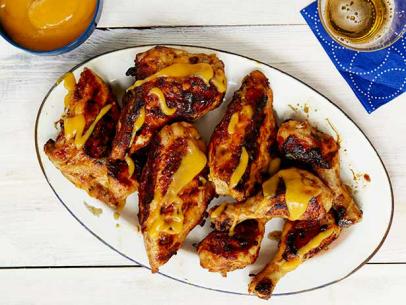
Recipe courtesy of Amanda Haas
Recipe courtesy of Amanda Haas
Watch how to make this recipe.
Buttermilk-Brined Turkey
Getting reviews...
- Level: Intermediate
- Total: 1 day 4 hr 30 min
- Active: 30 min
- Yield: 12 servings
In this lesson, you'll learn why a buttermilk brine results in tender, flavorful meat. Amanda Haas also shows you a clean, easy way to ensure even brining.
- Level: Intermediate
- Total: 1 day 4 hr 30 min
- Active: 30 min
- Yield: 12 servings
Ingredients
Buttermilk Brine
Turkey
Directions
- Buttermilk Brine: Pour water into a medium saucepan over high heat. Add salt and stir to dissolve; once all the salt has dissolved, remove from heat and add ice cubes to cool quickly.
- In a large stock pot, add basil, coriander seed, mustard seed, black peppercorns, bay leaves, and garlic powder. Add buttermilk, salt water, and stir.
- Rinse turkey inside and out with cold water. Line a stock pot large enough to hold the turkey with a brining bag. Place the turkey into the bag, then carefully pour in the buttermilk brine. (Optional: Use a pitcher to help transfer the brine.) Press out all the air, then seal the bag. Transfer the bagged turkey to a sheet tray and refrigerate for 24–36 hours, turning every 4 to 6 hours for even brining.
- Remove the turkey from the brining bag; discard the brine. Rinse the turkey inside and out with cold water and pat completely dry with paper towels, inside and out. Place the turkey breast side up on a rack in a large roasting pan. Twist and tuck the wing tips underneath the turkey. Cross the legs, then tie together with kitchen twine. Rub the skin evenly with butter. Let stand at room temperature for 1 hour. Meanwhile, position oven rack in the lower third of the oven and preheat to 400 F.
- Season the turkey all over with pepper. Roast the turkey for 30 minutes. Then reduce the oven temperature to 325 F and continue roasting, about 15 minutes per pound. After 1 hour of total cooking time, remove turkey from the oven, opening and closing the door as quickly as possible to maintain the temperature. Baste turkey with the juices that have accumulated in the pan. (Tip: For easier basting, tilt the pan to allow juices to collect on one side.) Check temperature by inserting a thermometer into the thickest part of the breast and thigh, away from the bone. The turkey is done when a digital thermometer registers 165 F at the thickest part of the breast and 175 F at the thigh. (At this point, the turkey won’t be done, but you will have a better idea of how much cooking time is left.) Continue roasting, basting and checking the temperature every 30 minutes. Total roasting time should be 2½–3½ hours.
- When turkey has reached temperature, immediately transfer to a carving board, cover loosely with foil, and let rest for 30 minutes before carving. (See the "How to Carve a Turkey" lesson for carving instructions.)

































